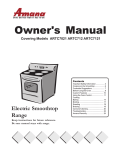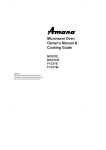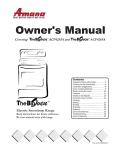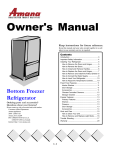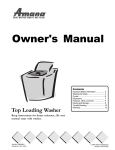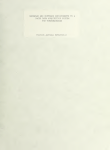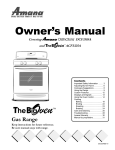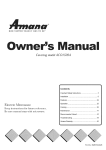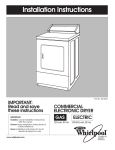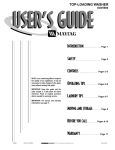Download Installation And Operating Instructions For Front Loading Washers
Transcript
Installation And Operating Instructions For Front Loading Washers Keep these instructions for future reference. Be sure this manual stays with washer. Attention Installer Wait until washer is within 4 feet of installation area to remove shipping brace and shock sleeve. Shipping brace and shock sleeve must be removed prior to operating machine. Para recibir un manual en español gratis, envíe por correo o por fax su nombre, dirección, y número de modelo a: Amana Appliances Consumer Communications/Spanish Manual 2800 220th Trail Amana, Iowa 52204-0001 USA Número de fax 1-319-522-8158 Contents Service ........................................................................ 2 Asure™ Extended Service Plan .................................. 2 Parts and Accessories ................................................ 2 Important Safety Instructions ....................................... 2 Model Identification ..................................................... 4 Electrical ..................................................................... 4 Tools ........................................................................... 4 Electrical Requirements .............................................. 5 Grounding Instructions ................................................ 5 Service Keep a copy of sales receipt for future reference or in case warranty service is required. Any questions or to locate an authorized servicer, call 1-800-NAT-LSVC (1-800-628-5782) inside U.S.A. 319-622-5511 outside U.S.A. Warranty service must be performed by an authorized servicer. Amana Appliances, also recommends contacting an authorized servicer if service is required after warranty expires. Installing Washer Water Supply Requirements .................................... 5 Water Temperature .................................................. 6 Water Pressure ........................................................ 6 Risers ...................................................................... 6 Installation Procedure .............................................. 6 Rough in Dimensions ............................................. 10 Asure™ Extended Service Plan Amana Appliances offers long-term service protection for this new washer. Asure™ Extended Service Plan is specially designed to supplement a strong warranty. This plan covers functional parts, labor, and travel charges. Call 1-800-528-2682 for information. Operating Washer Helpful Hints .......................................................... 11 Pauses ............................................................... 11 Boosted Hot Wash Temperature ......................... 11 Locking Door ...................................................... 11 Adding Clothes During Wash Cycle .................... 11 Detergents .......................................................... 11 Spin Cycle .......................................................... 11 Operating Instructions ............................................ 12 Determine Proper Cycle ...................................... 12 Wash Cycles ...................................................... 13 Operating Procedures ......................................... 14 Timer .................................................................. 16 “Door Locked” Light ............................................ 16 “Heater On” Light ................................................ 16 Out of Balance Load ........................................... 16 End of Cycle Signal ............................................ 16 Dispenser Drawer ................................................... 16 Child Lock .......................................................... 16 Detergent Compartment ...................................... 16 Liquid Bleach Compartment ................................ 17 Fabric Softener Compartment ............................. 17 To Clean the Dispenser ....................................... 17 Care and Cleaning ..................................................... 18 Cold Weather Care ................................................ 18 Care Of Your Washer ............................................. 18 Vacations and Extended Non-Use .......................... 18 Reinstallation of Shipping Materials ........................ 18 Before Calling Service ............................................ 19 Common Washer Sounds ...................................... 20 Warranty ................................................................... 21 Installer Checklist ...................................................... 22 Parts and Accessories Purchase replacement parts and additional accessories over the phone. To order accessories for your Amana product, call 1-800-843-0304 inside U.S.A. or 319-622-5511 outside U.S.A. For more information on this and other Amana products, visit our web site: www.amana.com Important Safety Instructions ! WARNING For your safety and to reduce the risk of fire or an explosion, do not store or use gasoline or other flammable vapors and liquids in the vicinity of this or any other appliance. 2 ! 15. Install the washer according to the Installation Instructions. All connections for water, drain, electrical power and grounding must comply with local codes and be made by licensed personnel when required. Do not do it yourself unless you know how! 16. To reduce the risk of fire, clothes which have traces of any flammable substances such as vegetable oil, cooking oil, machine oil, flammable chemicals, thinner, etc. or anything containing wax or chemicals such as in mops and cleaning cloths, must not be put into the washer. These flammable substances may cause the fabric to catch on fire by itself. 17. Do not use fabric softeners or products to eliminate static unless recommended by the manufacturer of the fabric softener or product. 18. Keep your washer in good condition. Bumping or dropping the washer can damage safety features. If this occurs, have your washer checked by a qualified service person. 19. Replace worn power cords and/or loose plugs. 20. Be sure water connections have a shut-off valve and that fill hose connections are tight. Close the shut-off valves at the end of each wash day. 21. Loading door must be closed any time the washer is to fill, tumble or spin. Do not attempt to bypass the loading door switch by permitting the washer to operate with the loading door open. 22. Always read and follow manufacturer’s instructions on packages of laundry and cleaning aids. Heed all warnings or precautions. To reduce the risk of poisoning or chemical burns, keep them out of the reach of children at all times (preferably in a locked cabinet). 23. Always follow the fabric care instructions supplied by the garment manufacturer. 24. Never operate the washer with any guards and/or panels removed. 25. Do not operate the washer with missing or broken parts. 26. Do not bypass any safety devices. 27. Failure to install, maintain, and/or operate this washer according to the manufacturer’s instructions may result in conditions which can produce bodily injury and/or property damage. WARNING To reduce the risk of fire, electric shock, serious injury or death to persons when using your washer, follow these basic precautions: 1. Read all instructions before using the washer. 2. Refer to the Grounding Instructions in the Installation Manual for the proper grounding of the washer. 3. Do not wash articles that have been previously cleaned in, washed in, soaked in, or spotted with gasoline, dry-cleaning solvents, or other flammable or explosive substances as they give off vapors that could ignite or explode. 4. Do not add gasoline, dry-cleaning solvents, or other flammable or explosive substances to the wash water. These substances give off vapors that could ignite or explode. 5. Under certain conditions, hydrogen gas may be produced in a hot water system that has not been used for two weeks or more. Hydrogen gas is explosive. If the hot water system has not been used for such a period, before using a washing machine or combination washer-dryer, turn on all hot water faucets and let the water flow from each for several minutes. This will release any accumulated hydrogen gas. The gas is flammable, do not smoke or use an open flame during this time. 6. Do not allow children to play on or in the washer. Close supervision of children is necessary when the washer is used near children. This is a safety rule for all appliances. 7. Before the washer is removed from service or discarded, remove the door to the washing compartment. 8. Do not reach into the washer if the wash tub is moving. 9. Do not install or store the washer where it will be exposed to water and/or weather. 10. Do not tamper with the controls. 11. Do not repair or replace any part of the washer, or attempt any servicing unless specifically recommended in the User-Maintenance instructions or in published user-repair instructions that you understand and have the skills to carry out. 12. To reduce the risk of an electric shock or fire, do not use an extension cord or an adapter to connect the washer to the electrical power source. 13. Use your washer only for its intended purpose, washing clothes. 14. Always disconnect the washer from electrical supply before attempting any service. Disconnect the power cord by grasping the plug, not the cord. Note: The Warning and Important Safety Instructions appearing in this manual are not meant to cover all possible conditions and situations that may occur. Common sense, caution and care must be exercised when installing, maintaining, or operating the washer. Always contact your dealer, distributor, service agent or the manufacturer about any problems or conditions you do not understand. 3 Model Identification Accessories Bag Thank you for purchasing this washer. Please read these Installation Instructions thoroughly. This manual provides proper maintenance information. Any questions, call the Consumer Affairs Department at 1-800-843-0304 inside U.S.A. and 1-319-622-5511 outside the U.S.A. An accessory bag has been shipped inside your washer. It includes: • Two inlet hoses with washers • Four rubber feet • Beaded Tie-Down Strap • Installation and Operating Instructions • Washing Guide • Bag for storing shipping materials • Video Retain accessories bag to store shipping brace and shock sleeve for future use when moving washer. Complete registration card and promptly return. If registration card is missing, call the Consumer Affairs Department. Appliance can also be registered through out website www.aman.com. When contacting Amana Appliances, provide product information. Product information is on the serial plate. Record the following information. Tools Tools required: 9 /16" wrench or adjustable wrench Screwdriver, Phillips and blade Level Pliers 9 /16" socket wrenches, and 5/16" socket wrench Deep Socket 9/16" socket wrenches for rear leveling legs Serial Plate Model Number: _________________________ Screwdriver Manufacturing Number: _________________________ Date of Purchase: _________________________ 6" 9/1 _________________________ 6" 9/1 S/N or Serial Number: Dealer's name and address: ______________________ ________________________________________________ Wrench Pliers Level Note: Deep socket wrench Socket wrench Translation may sometimes cause variations in meaning. In all cases where meaning varies, the most accurate meaning will be the English version of this document. Electrical Refer to serial plate for specific electrical requirements. For more detailed information refer to section on electrical requirements. Serial plate is located in area shown. Water Washer needs two standard 3/4" (19.05) mm) water supply faucets with a pressure between 20 –120 pounds per square inch (138 to 827 kPa). For more detailed information refer to section on Water Supply Requirements. 4 Installing Washer NOTE: Have a qualified electrician check the polarity of the wall receptacle. If a voltage reading is measured other than that illustrated, the qualified electrician should correct the problem. Electrical Requirements Washer requires 120 volt, 60 hertz and a 3-prong grounding plug. NOTE: Wiring diagram is located in the control hood. ! STANDARD 120 VOLT, 60 HERTZ, 3-WIRE EFFECTIVELY GROUNDED CIRCUIT WARNING L1 NEUTRAL GROUND To reduce the risk of fire, electrical shock or personal injury, all wiring must conform with the latest edition of the National Electrical Code, ANSI/NFPA 70, and such local regulations as might apply. It is the customer’s responsibility to have the wiring, fuses and circuit breakers checked by a qualified electrician to make sure your home has adequate electrical power to operate the washer. 120 ± 12 V.A.C. NEUTRAL SIDE DO NOT OVERLOAD CIRCUITS 0 V.A.C. 120 ± 12 V.A.C. ROUND GROUNDING PRONG DO NOT USE AN ADAPTER DO NOT USE AN EXTENSION CORD Water Supply Requirements Grounding Instructions ! Washer must be grounded. In the event of malfunction or breakdown, grounding will reduce the risk of electric shock by providing a path of least resistance for electric current. The washer is equipped with a cord having an equipment-grounding conductor and a 3-prong grounding plug. The plug must be plugged into an appropriate outlet that is properly installed and grounded in accordance with all local codes and ordinances. ! WARNING Under certain conditions, hydrogen gas may be produced in a hot water system that has not been used for two weeks or more. HYDROGEN GAS IS EXPLOSIVE. If the hot water system has not been used for such a period and before using the washer, turn on all hot water faucets and let the water flow from each for several minutes. This will release any accumulated hydrogen gas. The gas is flammable, do not smoke or use an open flame during this time. WARNING Improper connection of the equipment-grounding conductor can result in a risk of electric shock. Check with a qualified electrician or serviceman if you are in doubt as to whether the washer is properly grounded. NOTE: Water supply faucets must fit standard 3/4" (19.05 mm) female garden hose couplings. Do not use slip-on or clamp-on connections. Do not modify the plug provided with the washer – if it will not fit the outlet, have a proper outlet installed by a qualified electrician. 5 Installing Washer NOTE: Water supply faucets should be readily accessible to permit turning them off when washer is not being used. Risers Risers (or air cushions) may have to be installed if the pipes knock or pound when flow of water stops. The risers are more efficient when installed as close as possible to the water supply faucets. NOTE: Longer inlet hoses are available (optional at extra cost) if hoses supplied with the washer are not long enough for the installation. Order hoses as follows: A No. 20617 Inlet Hose, 8 feet (2.44 m) No. 20618 Inlet Hose, 10 feet (3.05 m) B B A C A. Risers (air cushions) Risers B. Water supply faucets Installation Procedure or 1. Position washer near installation area. Position washer so it is within 4 feet of desired area of installation. D E A. Water supply faucets C. Hot water connection E. Water inlet hoses Water hookup B. D. ! Cold water connection Water mixing valve CAUTION To avoid damage to washer, never move washer more then 4 feet without installing shipping brace and shock sleeves. Water Temperature Cold: Recommended cold water temperature is 60° to 80° Fahrenheit, 10° to 24° Celsius. 2. Connect Water Inlet Hoses. Remove two plain rubber washers from accessories bag. Install according to illustration below. Hot: Recommended hot water temperature is 120° to 140° Fahrenheit, 60° to 66° Celsius. A Warm: Mixture of hot and cold water. (Warm water temperature is dependent upon the water temperature and the pressure of both the hot and cold water supply lines). A B IMPORTANT: Turn off water supply faucets after checkout and demonstration. Owner should turn off water supply whenever there will be an extended period of non-use. A. Rubber washer Water supply hoses B. Inlet hose Turn on water supply faucets and flush lines for approximately two minutes to remove any foreign materials that could clog filter screens in water mixing valve. Water Pressure Pressure must be a minimum of 20 to a maximum of 120 pounds per square inch (138 to 827 kPa) static pressure measured at the faucet. NOTE: When installing in newly constructed or renovated building, it is very important to flush the lines since build-up may have occurred during construction. NOTE: Water pressure under 20 pounds per square inch (138 kPa) will cause an extended fill time in the washer and may not properly flush out the detergent dispenser. 6 Installing Washer IMPORTANT: To prevent siphoning, do not place any ribbed portion of the drain hose into the standpipe. IMPORTANT: Thread hose couplings onto valve connections finger-tight, then approximately 1/4 turn with pliers. DO NOT cross thread or overtighten couplings. B Turn water on and check for leaks. If leaks are found, retighten the hose couplings. Continue tightening and rechecking until no leaks are found. 3. Connect Drain Hose to Drain Receptacle C Remove drain hose from its shipping position on the rear of the washer by unhooking the hose from the retainer clamp. E D Ribbed portion or drain hose Drain hose sleeve 24" to 36" (91.44 cm) recommended height, it is not recommended to install drain pipe outside the recommended height range. D. Standpipe 2" (5.08 cm) or 11/2" (4 cm) E. Beaded tie-down strap Standpipe installation A A. B. C. B A. Retainer clamp B. Preparing drain hose for installation A Sink Installation For this type of installation, use the beaded tie-down strap (supplied in accessories bag), or use a large wire tie (available from your local hardware store) and secure the drain hose to the cabinet top hinge (see illustration). This will prevent the drain hose from dislodging. Drain hose Find the instructions that are appropriate for your type of drain receptacle (standpipe, sink, wall, or laundry tub). Follow these instructions to properly install the drain hose. A B IMPORTANT: Drain receptacle must be capable of handling a minimum of 1 1/4" (32 cm) outside diameter drain hose. C Standpipe Installation: Place the drain hose into the standpipe. Remove the beaded tie-down strap from accessories bag and place around standpipe and drain hose and tighten strap to hold hose to standpipe. This will prevent the drain hose from dislodging from drain receptacle during use. A. C. Drain hose B. Tie-down strap or wire tie 24" to 36" (91.44 cm) recommended height, it is not recommended to install drain pipe outside the recommended height range. Sink installation In The Wall Installation For installation of this type, the drain hose MUST be secured to one of the inlet hoses using the beaded tie-down strap from accessories bag. 7 Installing Washer NOTE: End of drain hose must be 24" to 36" above the floor. Without 24" to 36" high elevation, water may run out of washer prematurely. 4. Remove Shock Sleeves and Shipping Brace Remove 2 front access panel screws to remove access panel. Save screws. A B A B C A. Front access panel Access panel removal A. Drain hose B. Tie-down strap (tape if necessary) C. Inlet hoses In wall water hook up Access panel screws Remove five bolts and five washers from yellow marked shipping brace with a 9/16" socket wrench and remove brace. Remove label from outside access panel and place on inside of access panel. Laundry Tub Installation For this type of installation, the drain hose must be secured to the stationary tub to prevent hose from dislodging during use. Use the beaded tie-down strap (supplied in accessories bag) to secure hose. A B B B A. Drain hose Laundry tub installation B. A B. Tie-down strap A. Shipping brace Removing shipping brace 8 B. Bolts and washers Installing Washer Loosen inside locknuts using a 9/16" deep socket. Adjust level legs with a 1/4" socket on top of leg. Adjust legs until machine is level front to back, side to side and does not rock. Tighten locknuts using the 9 /16" deep socket. If locknuts are not tight, washer will move out of position during operation. • On front legs an open or box end wrench can be used in place of deep socket. Hold leg still with 1/4" socket on top of leg. use 9/16" wrench to tighten locknut. Remove both front shock sleeves and both rear shock sleeves by pulling on the yellow rope. A NOTE: Level must rest on raised portion of top panel. See illustration. A B B A. Shock sleeve B. Pull on cord to remove 4 shock sleeves Shock sleeve removal C F NOTE: 5 Bolts, shipping brace, 5 washers and shock sleeves should be saved and must be reinstalled whenever the washer is moved more than four feet. Do not lift or transport washer from front or sides or without shipping materials installed. E D A. Level, washer should be level front to back and side to side B. 1/4" hex, top of leveling leg C. Locknut D. Leveling leg E. Rubber foot F. Washer base Leveling washer Store shipping materials in Accessories Bag. Save materials for use whenever the washer is moved. Refer to Shipping Brace Removal and Installation section for instructions on installation. Reinstall front access panel. 5. Position and Level Washer 6. Electrical Connection Position washer on a clean, firm, and level floor. Remove rubber feet from accessories bag. Place rubber feet on all four leveling legs. Refer to section on Electrical Requirements, and plug in washer. Installing washer on any type of carpeting or soft vinyl flooring is not recommended. These surfaces contribute to vibration and a tendency for the washer to move during the spin cycle. NOTE: Do not slide washer across floor if leveling legs have been extended or rubber feet have been installed, legs and base could become damaged. Plug in washer NOTE: Use of the dispenser drawer, door or control panel as a handle in moving of washer may cause damage to these parts. 9 Installing Washer 7. Check Installation Refer to Installer Check on back cover of this manual and make sure that washer is installed correctly. 8. Verify Washer Operation Push timer knob in and turn to RINSE & SPIN cycle to ensure washer is operating correctly. Close door and pull knob out to start the washer. Verify that water enters the wash tub, the wash tub rotates, water is drained out and the wash tub spins dry. Verify washer operation Rough in Dimensions 28" (71.1 cm) 14.6" (37.1 cm) 28" (71.1 cm) 2" (5.1 cm) 10 30.9" (78.5 cm) 43.6" (110.7 cm) 36.6" (93 cm) 16.8" (42.7 cm) 26.9" (68.3 cm) Operating Washer Helpful Hints Adding Clothes During Wash Cycle To avoid delays to wash cycle make sure all items are placed in washer before starting washer. If it is necessary to add or remove items from the washer while it is operating, perform the following steps: There is no agitator on this washer. Instead, clothing gently tumbles through water. Wash action consists of a period of tumbling in one direction, a brief pause, then a reverse tumble in opposite direction. Pauses are part of tumble action and add to the unique soaking and cleaning action of the washer. Do not attempt to turn timer through these pauses. Pauses are part of the wash cycles. 1. Push timer knob in to stop the wash cycle. 2. Wait until “Door Locked” light goes off (“Door Locked” light will take a minimum of 45 seconds to shut off when the wash cycle has been interrupted.) 3. Open door. Add or remove items, close door. • Water level will be below the level of the door so overflow out of door will not occur. 4. Adjust timer knob (if needed) and pull timer knob out to restart cycle. Pauses This washer has pauses in its operation that are part of its normal operation. Pauses occur at the following times: • During washing and rinsing tumble action there is a 8 to 10 second pause while the tumbling action reverses. • Washer is heating water during the Boosted Hot setting. Washer will heat for approximately 55 seconds perform a 5 second tumble and then repeat until water is correct temperature. • Between wash and rinse cycles for 15 to 30 seconds. Detergents See Dispenser Drawer instructions for adding detergents. • Low sudsing detergents are recommended for use with high efficiency or front loading washing. To identify these detergents look for High Efficiency (HE) graphic on the detergent package. • If using detergents made for topload washers, avoid oversudsing by using 1/3 the recommended detergent amount. Cleaning performance may be affected when using the lesser amount. Boosted Hot Wash Temperature • When Boosted Hot setting is selected, the built-in heating element will boost the water temperature in the wash tub to 140°. When the heating element is operating the “HEATER ON” light will come on. The timer will not advance until the water temperature reaches 140°. (See setting WASH/RINSE temperature instructions for temperature selection) • Time needed to reach 140° depends on the load size and the temperature of the incoming water. This can vary from 30 to 60 minutes. • Boosted Hot setting can be turned off by rotating the WASH/RINSE TEMPERATURE selector to any other setting (rotating the cycle will cause a pause in the cycle of approximately one minute.) NOTE: The glass door allows viewing of suds level. The normal level of suds should be below the center of the door. If suds level is too high, the amount of detergent used should be reduced during next cycle. Extra Rinse cycle may also be selected. Spin Cycle When washer goes into its spin cycle, there will be a noticeable increasing and decreasing of the spin speed of the washer wash tub. The washer will slowly tumble the clothing items between rapid spins. During the final spin, there will be a noticeable increase in the spin speed before the washer goes into a final fluff. Locking Door • Door locking mechanism is a safety feature that keeps the door securely shut during operation. Door can not be opened while washer is in operation. • The “Door Locked” light must be on for the unit to operate. • If power to washer is interrupted or there is a power outage during operation, there will be a minimum of 45 second delay before door can be opened even if DOOR LOCKED light goes off. Loading Washer This front load washer operates best when fully loaded. Maintaining a balanced load is important for proper operation. A single item or very small load can not be evenly balanced. Make sure several items are in the wash tub when starting cycle. 11 Operating Washer Operating Instructions ! Permanent Press/Knit Cycle Use for permanent press items and synthetics. Wash time selection will depend upon type of fabric and amount of soil. There are two settings in the PERMANENT PRESS/KNITS cycle—Normal and Light. Number shown next to these settings is length of tumbling in minutes. (For example: Setting timer on Normal will be a nine minute tumble, including pauses.) WARNING To reduce the risk of fire, electrical shock, serious injury or death to persons, read the IMPORTANT SAFETY INSTRUCTIONS on pages 3 and 4 before operating your washer. Determine Proper Cycle Delicate Cycle Wash delicate items that typically get washed by hand, in this cycle. There are two settings in the DELICATE cycle—Normal and Light. Number shown next to these settings is length of tumbling in minutes. (For example: Setting timer on Normal will be a seven minute tumble, including pauses.) Regular Cycle Use for sturdy items, play or work clothes, towels, T-shirts, etc. Wash time selection will depend on type of fabric and amount of soil. When cleaning heavily soiled items, use prewash setting and a longer wash time (15 minutes maximum). Lightly soiled items require less wash time. Rinse and Spin Cycle Use for items that only need to be rinsed. This cycle is also useful in ridding your washer of suds when too much detergent has been used. Regular Cycle contains four settings—Prewash, Heavy, Normal and Light. Prewash setting is for heavily soiled or stained clothing. Number shown next to Heavy, Normal, and Light settings is the length of tumbling in minutes. (For example: Setting timer on Heavy will be a 15 minute tumble, including pauses.) NOTE: Rinse and Spin setting can be used to help completely remove excess soap from any wash setting. NOTE: Detergent will not be dispensed during the Prewash setting. Use a spot remover directly on stains when using this setting. To add detergent during a Prewash cycle, add powder into the wash tub, add liquid detergent into the detergent dispenser. If liquid detergent is used, you will need to add detergent to the dispenser during the wash portion of the cycle also. 12 Operating Washer Wash Cycles Each wash cycle includes several different settings. The following chart lists what can be expected during the cycles selected. Regular Cycle Activity Prewash (Optional) Fill, Tumble, Rinse & Drain Heavy, Normal, Light Fill & Tumble Spin Pulse Spin Rinse 1 Fill & Tumble Spin Pulse Spin Rinse 2 Fill & Tumble Final Spin* Medium & Fast Spin Extra Rinse (Optional) Fill & Tumble Spin Medium & Fast Spin Fluff Tumble 48 minute total cycle time, cycle time will vary with fill rate. Water Temperature Boosted Hot, Hot, Warm or Cold Boosted Hot, Hot, Warm or Cold Cold Warm or Cold* Warm or Cold Rinse and Spin Rinse Spin 17 minute total cycle time. Fill & Tumble Medium & Fast Spin, Tumble Warm or Cold Permanent Press/Knits Cycle Normal, Light Fill & Tumble Spin Pulse Spin Rinse 1 Fill & Tumble Spin Pulse Spin Rinse 2 Fill & Tumble Final Spin* Slow & Medium Spin Extra Rinse (Optional) Fill & Tumble Spin Medium Spin Fluff Tumble 38 minute total cycle time, cycle time will vary with fill rate. Boosted Hot, Hot, Warm or Cold Cold Warm or Cold* Warm or Cold Delicate Cycle Normal, Light Fill & Slow Tumble Boosted Hot, Hot, Warm or Cold Spin Pulse Spin Rinse 1 Fill & Slow Tumble Cold Spin Pulse Spin Rinse 2 Fill & Slow Tumble Warm or Cold* Spin Slow Spin Extra Rinse (Optional) Fill & Slow Tumble Warm & Cold Spin Slow Spin Fluff Slow Tumble 33 minute total cycle time, cycle time will vary with fill rate. * If extra rinse is selected the final spin will be medium speed only. * Rinse 2 will give a cold rinse when the optional Extra Rinse is selected. Extra Rinse adds approximately 15 minutes to the cycle time. 13 Operating Washer Operating Procedures ! ! WARNING To reduce risk of serious injury, do not attempt to bypass loading door switch permitting washer to tumble or spin with the loading door open. Caution To prevent property damage or damaging washer verify the following before using the washer: • Washer cord is plugged into a 120 volt electrical outlet that has the proper grounding and polarity. • Washer hoses are connected to the hot and cold water faucets and faucets are turned on. • Drain hose is not kinked and is inserted into a drain. 5. Set WASH/RINSE temperature. See Installation section of this manual for proper washer installation. IMPORTANT: Prior to first wash, use an all-purpose cleaner, or a detergent and water solution with a damp cloth to remove shipping dust from inside washtub. 1. Prepare clothes for washing. Sort items into separate loads, empty pockets and cuffs, pretreat stains and heavily soiled areas. See Washing Guide provided in literature packet for wash preparation instructions. 2. Measure and add high efficiency (HE) detergent, fabric softener, and bleach to the dispenser drawer. See Dispenser Drawer instructions for dispenser usage. 3. Load clothes into wash tub. • Washer has automatic water level adjustment. Water level will be adjusted to the size of each load. • When loading washer, clothes should fill the wash tub but should not be packed. • Wash loads can be too small. Wash load should be large enough so that clothes can be evenly distributed around the drum during spin. 4. Close loading door tightly. Washer will not operate with the door open. Water temperature dial There are five WASH/RINSE temperatures available— Boosted Hot Wash/Cold Rinse, Hot Wash/Cold Rinse, Warm Wash/ Cold Rinse, Warm Wash/Warm Rinse, and Cold Wash/Cold Rinse. See chart below for temperatures that work best for your garments. ! WARNING To prevent personal injury do not touch door glass when Boosted Hot and Hot wash cycles are selected. Windows may be hot. NOTE: Always follow Manufacturer’s Care Labels. NOTE: Energy Saver settings, marked with a dot (•), show which temperature settings will use the least energy. 14 Operating Washer Boosted Hot Approximately 140° F Hot Approximately 120° F (Or as determined by home hot water supply) Warm Approximately 100° F • • • • • • • • • • • • Cold Approximately 65° F • • • • 6. Select “EXTRA RINSE” if desired. Sturdy whites and colorfast items Work Clothes Heavily soiled items Diapers Sturdy whites and colorfast items Work clothes Soiled items Diapers Light and moderately soiled items Non-colorfast or dark colors. Permanent press Silks, woolens, nylon, acrylic Rinsing of some items Non-colorfast items Extra delicate clothing Rinsing of most items Extra Rinse control is useful for people with detergent sensitive skin. By pressing the “Extra Rinse” to “ON”, the Regular, Permanent Press/Knits, or Delicate cycles will each provide an additional rinse. When extra rinse is not wanted, “OFF” should be selected. Extra Rinse will add approximately 10 to 15 minutes to the total cycle time. • Extra Rinse is useful for removing detergent for sensitive skin. Extra rinse button 7. Select cycle according to type of fabric being washed. Push timer knob in and turn clockwise to desired cycle and wash time. Use indicator dot on knob as a guide. Boosted Hot Wash Boosted Hot Wash will boost water temperature in tub to 140° F and is useful for improved cleaning of some loads. “Heater On” light will be on when the heating element is on. Timer will not advance until 140°F has been reached. Time needed to reach this temperature may add an additional 30 to 60 minutes to the cycle time. Hot water is the most effective for cleaning but it is not recommended for all fabric types (read labels). NOTE: Boosted Hot Wash can be turned off by rotating the WASH/RINSE temperature to another setting. (The washer may pause for a short time when this change is made.) Cycle knob NOTE: There will be extended pauses with tumbling action when BOOSTED HOT WASH is selected because water is being heated. 8. Pull timer knob out to start washer. “DOOR LOCKED” light will come on after a short delay, water fill will begin, and wash tub will begin tumbling. NOTE: Washer door MUST be closed tightly to start washer. Adding Items during wash cycle If adding items after a cycle has already started perform the following steps: • Push timer knob in. There will be approximately a minute delay as “Door Locked” light goes out. • Open door and add or remove items. • Adjust timer knob (if desired) and pull timer knob back out to restart cycle. 15 Operating Washer Timer Dispenser Drawer Although wash cycles are automatic, the timer may be reset to lengthen, shorten or repeat a portion of a cycle. Child Lock Dispenser drawer has a child lock. Slide the latch (located inside the handle) to the right to lock the drawer, if desired. Slide latch to the left to unlock door. To set or reset the timer, push timer knob in to stop the washer. Hold timer knob in firmly while slowly turning it clockwise to the setting desired. Pull timer knob out to start washer. “Door Locked” Light When washer is started the “Door Locked” light will come on after a short delay. Light will turn off when the cycle is complete. “Heater On” Light This light comes on during the Boosted Hot setting only. While the washer is heating the “Heater On” light will turn on. The light will go off when the washer tumbles and will come back on when the heater is on. A A. Child Lock Child lock location Out of Balance Load If at the end of the cycle, the load is noticably wet, washer has limited the spin speed. Limiting the spin speed will prevent damage to the washer if there is a severely unbalanced load. Detergent Compartment Detergent compartment is located on the right side of the dispenser drawer. High Efficiency (HE) powdered or liquid detergents are recommended for use with front loading washers. Powdered bleach can also be used in the dispenser along with the detergent. If this condition occurs, redistribute the load manually and repeat the cycle beginning at the last rinse. If the condition persists, consider steps discussed in the Washing Tips section of Washing Guide. Compartments for detergent, fabric softener and bleach are larger than what is needed per load to help avoid spills. Do not overfill dispenser with detergent. Filling dispenser cavity completely with detergent will result in oversudsing and a decrease in cleanability. Use only amount of detergent recommended by detergent manufacturer. Wash loads can be too small. Wash load should be large enough so that clothes are evenly distributed around the drum during spin. If load is too small, add clothes to wash tub. End of Cycle Signal NOTE: If using detergents made for topload washers, avoid oversudsing by using 1/3 of the recommended amount. Cleaning performance may be affected when using lesser amounts. Use care when adding detergent so as not to spill into the other compartments. Detergent mixed with fabric softener can make the softner gummy. NOTE: The normal level of suds should be below center of the door. End of cycle signal Volume of the signal tone may be set on OFF, LOUD or between the two selections. If a volume level is selected, the signal tone will buzz on and off when the cycle is completed. Signal will stop when the door is opened or when the timer has advanced to an OFF position. 16 Operating Washer Fabric Softener Compartment A The fabric softener compartment is located in the left rear corner of the dispenser drawer. A A. Detergent compartment Detergent dispenser location A. Fabric softner dispenser Fabric softner dispenser location Liquid Bleach Compartment Bleach compartment is located in the left front corner of the dispenser drawer. It has been designed to prevent the dispensing of undiluted bleach onto the clothes load. Use no more than the maximum level indicated for the fabric softener compartment. Adding more than the maximum amount could result in early dispensing of the product and possible staining of fabrics. A Add fabric softener to compartment before beginning washload. The fabric softener will be dispensed during the last rinse cycle. Carefully close dispenser door. Do not allow softener to spill into other compartments. To Clean the Dispenser A. Bleach compartment Bleach dispenser Remove the dispenser drawer from the washer by firmly pulling the drawer straight out, past the stop position. Rinse dispenser drawer in hot water. A small brush may be used to thoroughly clean out any residue. After cleaning, reinstall the dispenser drawer. Use liquid bleach in the dispenser. Powdered bleach must not be used in this compartment. Powdered bleach can be used in the detergent compartment only and can be added along with the detergent. Small amounts of water may be discovered in the dispenser drawer. This condition is normal. Water may be removed by removing the dispenser drawer and pouring the water out. DO NOT use more than the maximum level indicated for the bleach compartment. Adding more than the maximum amount could result in early dispensing of the product and possible damage to fabrics. Carefully pour recommended amount of bleach into the compartment before starting wash load. Be careful not to spill undiluted bleach. It is a strong chemical and can damage some fabrics if it is not properly diluted. Follow bleach manufacturer’s label for proper use. Carefully close dispenser door. Do not allow bleach to spill into other compartments. 17 Care and Cleaning Cold Weather Care 2. Place the shock sleeves on all four shock absorbers. (See illustration) If the washer is delivered on a cold day (below freezing), or is stored in an unheated room or area during the cold months, do not attempt to operate it until the washer has had a chance to warm up to room temperature. A Care Of Your Washer B • Use only a damp or sudsy cloth for cleaning the control panel. Some cleaning product sprays may harm the finish on the control panel or damage the interior of the hood. • Wipe the washer cabinet as needed. If detergent, bleach or other washing products are spilled on the cabinet, wipe immediately. Some products will cause permanent damage if spilled on the cabinet. • Do not use scouring pads or abrasive cleansers. • Do not lay sharp or rough objects on or against the washer. The finish could be damaged. • The wash tub and window will need no particular care although they may need rinsing or wiping after an unusual load has been washed. Outside of window can be cleaned with household window cleaner. • Leave the loading door open to allow the inside of the washer to dry out after use. This helps prevent musty odors from developing. • Do not allow small children to play on or around the washer. • Do not move washer without reinstalling shipping brace. See instructions below for shipping brace installation. A. Shock sleeve Reinstalling shock sleeves B. Shock absorber 3. Insert hooked end of shipping brace into the open slot of the motor mount. Attach with bolts and washers to anchor bracket to machine. (See illustration) B B Vacations and Extended Non-Use Important: To avoid possible property damage due to flooding, turn off the water supply to the washer whenever there will be an extended period of non-use. Leave door open so that moisture inside machine can evaporate preventing mold or mildew from growing. A B A C A. Shipping brace B. Bolts and washers C. Cut-away view of washer cabinet to illustrate location of shipping brace Reinstalling shipping brace Reinstallation of Shipping Materials 1. Remove front access panel by removing two screws. 4. Reinstall front access panel. Refer to the Installation Instructions for proper procedures whenever the washer is moved. A B A. Front access panel Access panel removal B. Access panel screws 18 Care and Cleaning Door will not open or close. • Make sure control knob is all the way pushed in when stopping washer. • Wait. It will take at least 45 seconds for the door lock mechanism to disengage. • Weight of wet clothes may be pushing on inside of door. Push in slightly on door and then try to open. Before Calling Service You may save time and money by checking the items listed below. If you have a question not explained below contact Amana Consumer Information at 1/800-843-0304. Washer will not fill. • Close the door tightly. • Check the house circuit breaker to make sure the breaker does not need replacement. • Make sure washer is plugged into a live electrical outlet. • Verify that inlet hoses are not pinched preventing water from entering washer. • Make sure both hot and cold faucets are turned on completely. • Clean the filter screens in valve openings. Owner is responsible for service calls regarding cleaning of the screens. Washer stops. • This may be a pause in the cycle, a soak period, or washer may be heating water. Wait and it may start. • Check the house circuit breaker to make sure the breaker does not need replacement. • Make sure electrical cord is plugged all the way into electrical outlet. Washer leaks water. • Make sure hose connections are tight. • Make sure end of drain hose is correctly inserted and secured to drain facility. • Make sure washer was not overloaded, or too much detergent was put in dispenser. • If washer drains to a standpipe, make sure standpipe is not overflowing during drain portion of cycle. Washer will not start. • Be sure power cord is plugged all the way into the electrical outlet. • Close the loading door tightly. • Check the house circuit breaker to make sure the breaker does not need replacement. • Pull timer knob out to start the washer. Check to make sure timer is not set at an OFF position. Washer is excessively noisy. • See Common Operating Sounds section in this manual. • Clanging heard during tumbling can be caused by loose change or buckles. Check for loose change in wash tub and remove. Make sure all clothing has zippers zipped up, clothing with buckles must be turned inside out. • Make sure shipping brace and shock sleeves have been removed. • Make sure washer is level. See “Installation Instructions” for leveling. • Floor may not be strong enough for washer. See Installation Instructions for recommended type of floor. • If noise persists in successive loads, or a loud banging develops, contact an authorized Amana technician. Washer will not tumble • Close door tightly. • Check the house circuit breaker to make sure the breaker does not need replacement. • Are controls properly set. See Operating Instructions for setting controls. • Drive belt may be broken. Call Amana technician. Washer will not spin • Close door tightly. • Wash load may be out of balance, stop load and redistribute clothing, or add clothing if load is too small. • Check the house circuit breaker to make sure the breaker does not need replacement. • Are controls properly set. See Operating Instructions for setting controls. • Drive belt may be broken. Call Amana technician. Washer fills with the wrong temperature water. • Make sure both faucets are turned on fully. • Make sure temperature control knob is turned to desired setting. • Make sure water inlet hoses are connected to correct faucets and inlet connections. • Check water heater setting. Water heater should be set to a minimum of 120°. Washer will not drain • Make sure drain hose is not twisted or kinked. • Make sure drain hose is installed within recommended height range. See Installation Instructions for recommended height range. 19 Care and Cleaning Washer signal comes on and remains on • Unplug washer wait approximately 5 seconds and plug washer back in. • Washer may not be getting enough water. Make sure faucets are turned on fully. This situation should be accompanied with a signal warning. • Make sure water inlet hoses are connected to correct faucets and inlet connections. • Make sure something in washload is not tangled preventing wash load from tumbling. • After checking these items and washer signal is still on, unplug washer, shut off water and contact a service person. If after reviewing this information you are still unable to solve problem contact an authorized servicer. If you are unable to locate an authorized service center or are unsatisfied with the service performed on your washer, contact: Amana Appliances 2800 220th Trail Amana, Iowa 52204-0001 Phone: 1-800-843-0304 Fax: (319) 622-2977 ! Clothes are still wet after cycle is complete • Wash load may have been out of balance. Redistribute clothes and put clothes through an extra spin cycle. If washer has not completed its cycle, EXTRA RINSE cycle can be selected. • If a power outage occurred during cycle, may not have been able to go through complete spin. Extra spin should be selected to remove moisture. • May have been too much detergent. Reduce detergent amount for next cycle. WARNING To reduce the risk of serious injury or death, do not repair or replace any part of the washer or attempt any servicing unless specifically recommended in the usermaintenance instructions or in published user-repair instructions that you understand and have the skills to carry out. If power is disconnected from washer • When power is disconnected from the washer, door can not be opened immediately. There will be a minimum of a 45 second delay before door will unlock. • Clothes may still be wet when removing from washer. A disconnection from power will often not allow washer to go through a complete spin cycle. Extra spin should be selected or push in control knob and turn control knob back to spin setting. Washer is Vibrating excessively • Make sure washer is level. See Installing Washer for leveling information. • Check wash load. If wash load is not evenly distributed rearrange wash load for a more even clothing distribution. • May not be enough clothing in the washer. Wash loads can be too small. It may be neccesary to add clothing items to the wash load. There should be enough clothes in the washer to evenly distribute around wash tub when spinning. • Floor may not be strong enough for washer. See Installing Washer for type of floor recommended. • Make sure shipping brace and shock sleeves have been removed before using washer. See Installing Washer for shipping brace and shock sleeves removal. • Make sure locknut is tightened on leveling leg. • Make sure rubber feet are placed underneath leveling legs. 20 Care and Cleaning Common Washer Sounds 1. Accelerating Sound is heard during the spin portion of every cycle. Spin speed will increase and decrease during the spin cycle. The washer will reach the highest spin speed during the end of the cycle. 2. Tapping These sharp sounds may come from metal fasteners, zippers, belt buckles or coins hitting the wash tub or door glass. 3. Thumping Washer may be out of balance. Washer is designed to balance the load. If the washer is severely unbalanced, push timer knob in to stop washer, wait for door to unlock, and redistribute the load. 4. Rumbling Washer may not be level. Stop washer and adjust leveling legs. See Installation Instructions for details. 5. Flushing Water enters the dispenser to flush detergent, bleach and/or fabric softener into the tumbler during the appropriate time of the cycle. 6. Water Running This washer adjusts the water level automatically. Water is added at the beginning of the cycle until the wash tub contains the needed amount of water. If noise is in dispenser area see “Flushing” above. 3 5 4 6 2 1 21 Warranty Home Laundry Tumble Action Washer Product Full Two Year Warranty Full Five Year Warranty on Drive System Limited Five Year Warranty on Cabinet Limited Twenty Year Warranty on Stainless Steel Inner and Outer Wash tub Warranty Provides For: FIRST TWO YEARS Amana Appliances will repair or replace any defective part free of charge. FIRST FIVE YEARS Amana Appliances will replace any defective drive system assembly free of charge. Drive system includes motor, belt, pulleys and shaft assembly. THIRD THRU FIFTH YEARS Amana Appliances will provide a free replacement part, f.o.b. Amana, Iowa for any cabinet which proves defective to rust. THIRD THRU TWENTIETH YEAR Amana Appliances will provide a free replacement part, f.o.b. Amana, Iowa for any defective stainless steel inner and outer wash tub. WARRANTY LIMITATIONS • Warranty begins at date of original purchase. • Applies only to product used within the United States or in Canada if product is approved by Canadian Standards Association when shipped from factory. • Products used on a commercial, rental, or leased basis are not covered by this warranty. • Service must be performed by an authorized Amana service. • Adjustments covered during the first year only. WARRANTY IS VOID IF: • Serial plate is defaced • Product has defect or damage due to product alteration, connection to an improper electrical supply, shipping and handling, accident, fire, floods, lightning or other conditions beyond the control of Amana. • Product is improperly installed or applied. Owner’s Responsibilities • Provide proof of purchase (sales receipt). • Normal care and maintenance • Having the product reasonably accessible for service. • Pay for service calls related to product installation or usage instructions. • Pay for premium service costs, over normal service charges, if servicer is requested to perform service outside servicer’s normal business hours. IN NO EVENT SHALL AMANA BE LIABLE FOR INCIDENTAL OR CONSEQUENTIAL DAMAGES* *This warranty gives you specific legal rights, and you may have others which vary from state to state. For example, some states do not allow the exclusion or limitation of incidental or consequential damages, so this exclusion may not apply to you. For warranty service, contact an authorized Amana servicer. Should you have a service problem that is not resolved locally, Write: Amana Appliances 2800 220th Trail P.O. Box 8901 Amana, IA 52204 Or Phone in U.S.A.: 1-800-843-0304 If outside U.S.A.: (319)-622-5511 Installer Checklist Quick Checklist for Installing Washer (Refer to manual for more detailed information) 1 2 3 4 5 Quick Reference For Operating Washer Quick reference for operating washer (Refer to manual for more detailed information) • Position Washer near Installation Area. See page 6. 1 • Prepare clothes for washing. See Washing Guide provided in literature packet for wash sorting instructions. • Connect water inlet hoses. See page 6. 2 • Load clothes in wash tub. Clothes should fill the wash tub but should not be packed into the wash tub. See page 14. • Connect drain hose to drain receptacle. See page 7. 3 • Set WASH/RINSE temperature. See page 14. • Remove access panel. Remove the shipping brace and shock sleeves. See page 8. 4 • Position and level the washer. See page 9. 5 • Select EXTRA RINSE if desired. See page 15. • Add detergent to detergent dispenser. Do not fill detergent dispenser cavity with detergent. Use high efficiency detergent or 1/3 of the recommended amount of regular detergent. • Add bleach and/or fabric softner if desired. See page 16. 6 • Plug in washer. See page 9. 7 • Verify Washer operation. See page 10. Part No. 686938 Printed in U.S.A. Detergent dispenser CPW13 0C 6 • Select cycle according to type of fabric being washed. Pull out knob. See page 15. ©1998 Amana Appliances Amana, Iowa 52204

























